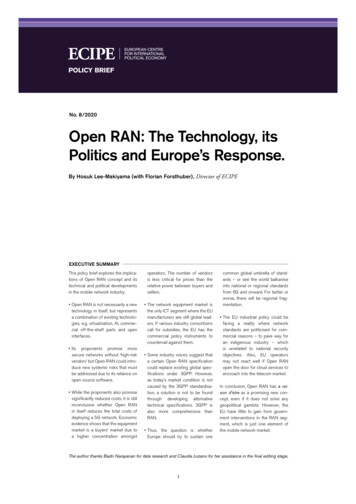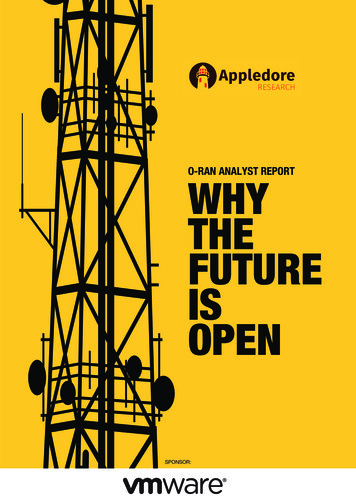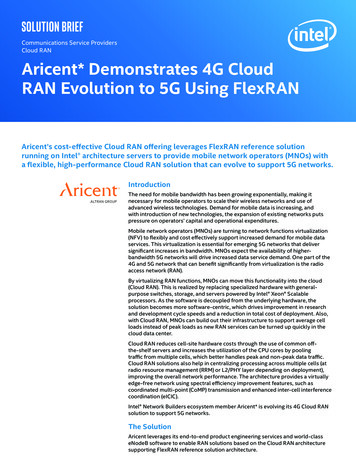
Transcription
Open RAN Policy Roadmap
Objective: Support the emergence of new network infrastructure vendorsEstablish tax incentives that stimulate private sector investment, such as thedeductibility of research and development expenditures. This de-risks companies’initial investment, incentivizing more companies to enter the market, particularlysmaller organizations.Provide direct funding for research and development, such as through directfunding of research or launching industry competitions (see U.K. example).Convene multi-stakeholder partnerships, such as between the private sector andspecialist research institutions.Publicly signal the government’s support for the adoption of Open RAN.Objective: Catalyze investment in technical capabilitiesConvene stakeholders to identify any technical challenges associated with OpenRAN.Provide direct government funding for research and development projects thataddress the issues identified.Support the convening of multi-stakeholder partnerships, such as thosebetween academia and industry.CASE STUDY FISCAL: STIMULATE SUPPLY UNITED KINGDOMOn April 6, the United Kingdom launched 5G Create, an open competition within its 5GTestbeds and Trials Programme. The competition makes available 30 million ofgovernment funding for developing 5G technical capabilities and new use cases. Amongthe cross-cutting challenges that they hope to address are:o Developing innovative virtualized and open RAN architectures; ando Exploring ways of diversifying the UK Telecoms supply chain.2
Objective: Support vendors’ integration into global marketplace for Open RAN solutionsEstablish mechanisms for new vendors to connect with operators internationally.(e.g. trade missions or forums).Identify opportunities for vendors and operators to leverage existing aid anddevelopment financing to promote Open RAN internationally.Objective: Support operators as they develop an approach to managing a multi-layernetwork architecture Provide funding for workforce development programs that ensure operators havethe human resource to manage networks in-house. Provide direct funding for operator pilots and testbeds.Support the identification of best-in-class network integrators, where operatorswish to outsource this function. Establish or support mechanisms for convening operators and vendors to sharebest practices around integration.Objective: Reduce operators’ initial cost of transitioning to an Open RAN architectureProvide incentives for the procurement of open, interoperable equipment bypublic mobile network operators and enterprise network operators while takinginto consideration the potential impact on competition between networkoperators in the market given the technical realities of transition to Open RAN (seeJapan example).Direct government agencies that administer funding (e.g. aid) and financing (e.g.development financing) mechanisms to utilize Open RAN procurementopportunities where feasible.3
CASE STUDY FISCAL: STIMULATE DEMAND JAPANIn May, the Japanese Diet passed the Act on Promotion of Development, Supply, andDeployment of Specified Advanced Information and Communication Technology UtilizationSystem. The Act provides financial incentives for companies that develop, supply or deploy5G equipment that meets certification criteria in terms of: security safety andtrustworthiness; stability of supply; and openness.The Government of Japan cites the need for equipment to be interoperable, based on openarchitecture, and utilize international standards to be certified. MNOs and private networkowners are eligible for tax benefits, which include the following:o Tax deductions of 15% or special depreciation of 30%o Fixed property tax exemption of 50% for 3 yearsObjective: Accelerate demand for Open RAN solutions Identify immediate government procurement needs that could be met through thedeployment of Open RAN solutions. Where feasible, engage with likeminded governments to identify opportunities forbulk procurement. Direct government agencies that administer funding (e.g. aid) and financing (e.g.development financing) mechanisms to support Open RAN procurementopportunities where feasible. Provide incentives for the procurement of open, interoperable equipment byMNOs and enterprise network operators while taking into consideration thepotential impact on competition between network operators in the market giventhe technical realities of transition to Open RAN (see Japan example). Incentivize open or virtualized RAN adoption in the telecoms sector.4
Objective: Establish the right approach to oversight of multi-vendor network architectureContinue to take a risk-based approach to the management of network securityand stability risks.Establish mechanisms for engagement with operators, enabling regulators to betterunderstand the construction of networks; giving operators the ability to highlightchallenges and share information regarding how security is incorporated intonetwork deployments. Encourage international security cooperation and the implementation of bestpractices for risk mitigation, such as those outlined in the Prague Proposals.Objective: Ensure that existing regulations do not unintentionally act as a barrierto Open RAN adoption Engage with network operators and vendors to identify regulatory barriers to 5Gand Open RAN deployments. Review existing regulations and, where feasible, adapt them to ensure a levelplaying field for Open RAN architectures, while maintaining the principle oftechnology neutrality and the ability of network operators to choose thetechnology solutions that meet their needs.Coordinate with international allies on the development and adoption of voluntary,flexible security principles, such as the Prague Proposals.Free up necessary spectrum bands for 5G and coordinate with international allieson the harmonization of spectrum bands.Note that many of these provisions apply equally to Open RAN and traditional RAN architectures.5
Objective: Support network operators in deploying Open RAN architectures that meetKPIs in more challenging environments (high density areas, non-standalone, etc.) Establish or provide funding for pilots and test beds. Establish public-private partnerships with industry and academia, focused onaddressing specific technical challenges.Create information sharing mechanisms with allies, through which informationabout research and technical breakthroughs can be shared, to avoid the duplicationof activities.Objective: Engage with international allies, given the international nature of the telecomsinfrastructure marketplace, to share experiences regarding how to promote supplierdiversity in the RAN Convene government-to-government meetings and multi-stakeholder discussions. Create information sharing mechanisms with allies, through which informationabout research and technical breakthroughs can be shared, to avoid the duplicationof activities.6
public mobile network operators and enterprise network operators while taking into consideration the potential impact on competition between network operators in the market given the technical realities of transition to Open RAN (see Japan example). Direct government agencies that administer funding (e.g. aid) and financing (e.g.










